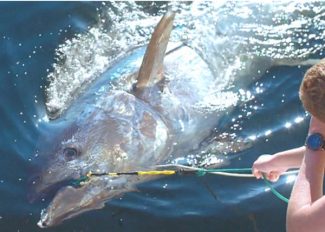Bluefin (John Hopkins, 2016): Canada
Reviewed by Rachel Gately. Viewed at Fiesta 5 Theater, Santa Barbara International Film Festival 2017
When John Hopkins, an award-winning cinematographer, noticed that the bluefin tuna population off the coast of Prince Edward Island (PEI) were no longer afraid of people, he became curious. Why are these 700 to 1,000 pound fish eating out of people’s hands? These are enormous gentle creatures that people think of not as beautiful beings in their own right, but simply as food. They are swimming right up to boatloads of tourists and fishermen alike. Is it fair to take advantage of this odd behavior?
This gorgeously presented documentary, with an abundance of wide drone shots of clear blue ocean and close ups of massive sea animals, cleverly explores the relationships among fishermen, tour guides, tourists, and the fish themselves. The fishermen, who stand to gain approximately $40,000 per fish, feel that scientists were wrong when they reported a 90% decline in population. They may have been gone for 10 years due to overfishing but they are back and better than ever. The tour guides, many of whom are off-season lobster fishermen, have no problem with the catch-and-release practices they have been employing for years to entertain the tourists. They don’t seem to mind that many fish are too damaged to be released and end up dying off the hook. Tourists, who flock to PEI at the rate of 1.1 million per summer, are awed by their size and entertained by their close proximity to the boats. The fish are happy to be hand fed and sometimes even petted, displaying no fear whatsoever of those who could easily harm them. This film follows in the footsteps of many other socially-conscious animal documentary films and reaches a similar conclusion to many of them.
In 2009, when Ric O’Barry and his team set out to clandestinely discover what was happening off the coast of Japan in the film The Cove they were not sure what they would find. The regular massacre of dolphin they discovered would lead them on a long journey into the worldwide fishing and food industries that would ultimately win them an Oscar. They brought to light fishing practices that many filmgoers saw as equivalent to human murder. Poor helpless dolphin, unafraid of humans, brutally killed en masse. The justification for saving them was written in the bloody water. Not so for Hopkins’ bluefin tuna population. Specifically because we view them as food, we humans are not inclined to help them. This created an issue for the filmmaker: how to tell the story without challenging the audiences’ dietary habits?
Environmentalists, scientists and fishermen alike find common ground on one point: if they continue to be overfished, the bluefin who live near PEI, the “tuna capital of the world,” will die out and no one will be able to enjoy them.Sushi lovers don’t want to know about the situation with these beautiful beings. Rather than telling the story from a one-sided perspective aiming to persuade us one way or another, Hopkins chose to simply present the situation as it is. By doing so, each audience member is left to reflect on their own. No one is questioning the fact that something is awry with their odd behavior. The question is: does it matter?
About this entry
You’re currently reading “Bluefin (John Hopkins, 2016): Canada,” an entry on Student Film Reviews
- Published:
- 02.21.17 / 1pm
- Category:
- Films, Santa Barbara Film Festival 2017

3 Comments
Jump to comment form | comments rss [?]